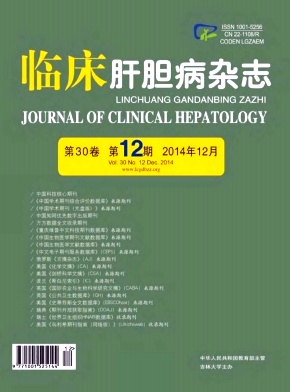|
[1]CHAWLA A, PUTHUMANA L, THULUVATH PJ.Autonomic dysfunction and cholelithiasis in patients with cirrhosis[J].Dig Dis Sci, 2001, 46 (3) :495-498.
|
|
[2]CONTE D, BARISANI D, MANDELLI C, et al.Cholelithiasis in cirrhosis:analysis of 500 cases[J].Am J Gastroenterol, 1991, 86 (11) :1629-1632.
|
|
[3]HU LH, LIAO Z, GAO R, et al.Comparison of complication and success rates of endoscopic retrograde cholangiopancreatography between 2001 and 2007:a retrospective report from Changhai hospital[J].Chin J Dig Endosc, 2009, 26 (5) :248-252. (in Chinese) 胡良皞, 廖专, 高瑞, 等.长海医院2001年与2007年ERCP成功率和并发症比较研究[J].中华消化内镜杂志, 2009, 26 (5) :248-252.
|
|
[4]TESTONI PA.Why the incidence of post-ERCP pancreatitis varies considerably?Factors affecting the diagnosis and the incidence of this complication[J].JOP, 2002, 3 (6) :195-201.
|
|
[5]PERMEY P, BERTHIER E, PAGEAUX GP, et al.Are drugs a risk factor of post-ERCP pancreatitis?[J].Gastrointest Endosc, 2003, 58 (5) :696-700.
|
|
[6] ZHOU YF, ZAHNG X, ZAHNG XF, et al.ERCP in patients with liver cirrhosis:an analysis of 156 cases[J].Chin J Hepatobiliary Surg, 2009, 15 (9) :647-650. (in Chinese) 周益峰, 张啸, 张筱凤, 等.156例合并肝硬化的胆胰疾患内镜临床分析[J].中华肝胆外科杂志, 2009, 15 (9) :647-650.
|
|
[7]YANG GY, TAO Y.Mechanism of hyperamylasemia in patients with liver cirrhosis[J].Int J Lab Med, 1985, 5 (1) :35. (in Chinese) 杨根远, 陶原.肝硬化患者高淀粉酶血症的机理[J].国际检验医学杂志, 1985, 5 (1) :35.
|
|
[8] HE Y, YUAN FY.Diagnostic relationship between liver and systemic disease[M].Beijing:People's Military Medical Press, 2002:122-123. (in Chinese) 何云, 袁凤仪.肝脏与全身系统疾病诊断关系[M].北京:人民军医出版社, 2002:122-123.
|
|
[9]LI XP, WANG JB, SUN KK.Safety of balloon dilation of the sphincter of Oddi for removal of common bile duct stones in patients with liver cirrhosis[J].Chin J Dig Endosc, 2007, 24 (3) :215-217. (in Chinese) 李小平, 王金波, 孙柯科.Oddi括约肌气囊扩张取石治疗肝硬化合并胆总管结石的安全性探讨[J].中华消化内镜杂志, 2007, 24 (3) :215-217.
|
|
[10]CHIJIIWA K, KOZAKI N, NAITO T, et al.Treatment of choice for choledocholithiasis in patients with acute obstructive suppurative cholangitis and liver cirrhosis[J].Am J Surg, 1995, 170 (4) :356-360.
|
|
[11]PARK DH, KIM MH, LEE SK, et al.Endoscopic sphincterotomy vs.endoscopic papillary balloon dilation for choledocholithiasis in patients with liver cirrhosis and coagulopathy[J].Gastrointest Endosc, 2004, 60 (2) :180-185.
|
|
[12]FERREIRA LE, BARON TH.Post-sphincterotomy bleeding:who, what, when and how[J].Am J Gastroenterol, 2007, 102 (12) :2850-2858.
|
|
[13]LI SP, XUE DQ, DU HW, et al.Endoscopic therapy for choledocholithiasis with liver cirrhosis and esophagogastric varices:an analysis of 52 cases[J].World Chin J Dig, 2012, 20 (32) :3154-3158.李素萍, 薛迪强, 杜宏伟, 等.内镜下治疗肝硬化食管胃底静脉曲张并胆总管结石52例[J].世界华人消化杂志, 2012, 20 (32) :3154-3158.
|
|
[14]LINGHU EQ, YANG YS, LI ZQ, et al.ERCP for patients with gastroesophageal varices combined with pancreatobiliary diseases[J/CD].Chin J Laparoscopic Surgery:Electronic Edition, 2011, 4 (5) :362-364. (in Chinese) 令狐恩强, 杨云生, 李志群, 等.食管胃静脉曲张患者伴胆胰疾病内镜下治疗的研究[J/CD].中华腔镜外科杂志:电子版, 2011, 4 (5) :362-364.
|
|
[15] LOU SM, ZHANG X, ZHANG XF.Comparison of two endoscopic therapies for liver cirrhosis with common bile duct stones[J].Zhejiang Med J, 2009, 31 (9) :1279-1280. (in Chinese) 楼颂梅, 张啸, 张筱凤.肝硬化并胆总管结石两种内镜治疗方案疗效的比较[J].浙江医学, 2009, 31 (9) :1279-1280.
|
|
[16]WU ZQ, FAN ZN, WANG M.Value of duodenoscopy in the treatment of biliary and pancreatic diseases complicated with hepatocirrhosis[J].Chin J Mini Invas Surg, 2011, 11 (8) :700-703. (in Chinese) 吴正奇, 范志宁, 王敏.十二指肠镜在治疗胆胰疾病合并肝硬变中的价值[J].中国微创外科杂志, 2011, 11 (8) :700-703.
|
|
[17]XU L, WANG F, ZHANG YF, et al.Efficacy of endoscopic sphincterotomy versus laparoscopic common bile duct exploration in treatment of common bile duct stones with liver cirrhosis[J].J Surg Concepts Pract, 2011, 16 (6) :587-588. (in Chinese) 徐琳, 王峰, 张宇飞, 等.内镜下乳头切开与开腹胆道探查治疗胆总管结石合并肝硬化的疗效比较[J].外科理论与实践, 2011, 16 (6) :587-588.
|
|
[18]MOREIRA VF, ARRIBAS R, SANROMAN AL, et al.Choledocholithiasis in cirrhotic patients:is endoscopic sphincterotomy the safest choice?[J].Am J Gastroenterol, 1991, 86 (8) :1006-1010.
|
|
[19]ZHANG Y, LIU D, MA Q, et al.Factors influencing the prevalence of gallstones in liver cirrhosis[J].J Gastroenterol Hepatol, 2006, 21 (9) :1455-1458.
|














 DownLoad:
DownLoad: